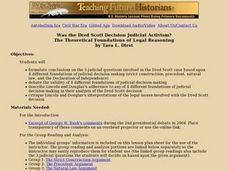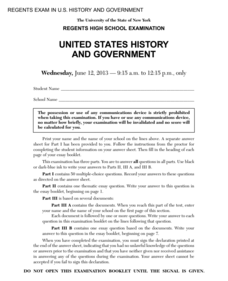State Bar of Texas
Dred Scott v. Sandford
Who decides someone is not a real person? Scholars investigate the Dred Scott v. Sandford court case which deals directly with slavery and citizenship. After viewing a short video clip, classmates work in pairs to assess and discuss the...
Fluence Learning
Writing About Informational Text: The Dred Scott Decision
Looking for a performance assessment that asks individuals to demonstrate their competency in writing about informational text? Use Frederick Douglass' essay "On the Dred Scott Decision," and an excerpt from Abraham Lincoln's 1857 speech...
National Constitution Center
Dred Scott v. Sanford
Dred Scott v. Sanford was a watershed moment for the country—and a key moment leading up to the Civil War. Using videos and analytical worksheets, scholars consider the facts of the case and then develop their own arguments before the...
DocsTeach
From Dred Scott to the Civil Rights Act of 1875: Eighteen Years of Change
What do a photo of Abraham Lincoln, a map for the Battle of Antietam, and the Dred Scott decision all have in common? Learners consider the broader question as they examine documents related to civil rights during the Civil War and...
Federal Judicial Center
Amistad and Dred Scott—a Comparative Activity
What do slaves fighting for their freedom on board a ship and a slave fighting for his freedom in a courtroom have in common? Budding historians investigate the two different cases of the Amistad slave revolt and the Dred Scott argument....
Curated OER
The Dred Scott Case (1857)
Students read and discuss Dred Scott v. Sandford Supreme Court case, describe in writing Constitutional principles and results of case, explain how Supreme Court decision may have helped further tensions between states, and answer...
Cornell College
Dred Scott v. Sandford Supreme Court Decision
Dred Scott was a harbinger of the Civil War. An enslaved man claimed freedom because his owner had taken him into free territory. Not only did the Supreme Court rule that Dred Scott and his wife were to remain enslaved, but it also ruled...
Curated OER
America responds to Dred Scott
Eleventh graders examine the reactions Americans had to the Dred Scott decision. In this American History lesson, 11th graders read editorials from newspapers. Students analyze these editorials and audio tapes from that time.
Curated OER
Dred Scott and the Constitution
Learners investigate the outcome of the Dred Scott case. In this human rights lesson plan, students read Justice Taney's decision about property rights and citizenship. Learners write essays about the outcome of the case and President...
Curated OER
Dred Scott v. Sandford
High schoolers examine the issues of slavery and due process. In this Supreme Court lesson plan, students examine primary documents from Dred Scott v. Sandford and discuss the implications of the decision.
Curated OER
The Dred Scott Decision
In this reading comprehension worksheet, students read a passage about the Dred Scott Decision and answer questions about what they read. Students write 4 short answers.
Curated OER
The Trial of Dred Scott
Students study the trial of Dred Scott. They investigate the New York Times reporter and simulate writing about the trial for a newspaper. They identify the 5Ws from the play using a graphic organizer and present their findings to the...
Curated OER
Before Dred Scott: Freedom Suits in Antebellum Missouri
Students examine and analyze original documents that enhance understanding of antebellum slavery in Missouri and a particular method of gaining freedom: the freedom suit.
Curated OER
Was the Dred Scott Decision Judicial Activism?
Students debate the validity of 4 different foundations of judicial decision-making. They describe Lincoln and Douglas's adherence to any of 4 different foundations of judicial decision-making in their analysis of the Dred Scott decision
Carolina K-12
Plessy v. Ferguson & the Roots of Segregation
How far in the past do the roots of Jim Crow and segregation extend? Young historians closely consider this question using detailed PowerPoint slides as a basis for discussion rather than lecture, culminating in an activity where class...
Curated OER
1850s: Road to Secession
Detailing the political and social events leading up to the Civil War, this presentation provides students with maps, political cartoons, and photographs to put this time period into historical context. The Presidential Elections of...
American Battlefield Trust
Pre-1860: Disunion
Using personas ranging from freed African Americans to wealthy plantation owners, young historians consider various points of view around the events in the days leading up to the Civil War including major milestones such as the Dred...
Curated OER
Underground Railroad
Eighth graders explore the Underground Railroad. In this American History lesson, 8th graders create a song about the railroad. Students analyze various symbols used during the Underground Railroad.
New York State Education Department
US History and Government Examination: June 2013
How successful has American foreign policy been in the past? Pupils consider the question as part of a state examination in American history. Other prompts include a document analysis and essay of important civil rights cases decided by...
New York State Education Department
US History and Government Examination: January 2011
The presidencies of John F. Kennedy, Richard Nixon, and Ronald Reagan were defined by the Cold War. Using primary source documents and scaffolded analysis questions, pupils explore the effect the Cold War had on these presidencies. A...
C-SPAN
Presidential Veto and Congressional Override
One of the key powers of the executive branch is the president's ability to pass or veto legislation proposed by Congress. Congress, the legislative branch, on the other hand, can override a president's veto. Five film clips show how the...
Digital Public Library of America
Frederick Douglass and Abraham Lincoln
Frederic Douglass and Abraham Lincoln, although dissimilar in their backgrounds, were united in their views about slavery. A set of 14 primary sources permits scholars to examine the views of these two powerful men.
K20 LEARN
Analyzing Early American Figures: Analyzing History
Who were they? High school freshmen brush up on their research skills by investigating an important person in American history. They select a name, fill out a KWHL chart, and research why their person is important. Scholars then complete...
Curated OER
The Deadly Equilibrium
Students determine if the economic model of slavery in the United States could or could not survive without expansion of slavery to the western territories. They access an excellent multi-media narrative imbedded in this plan.
Other popular searches
- Dred Scott vs. Sanford
- Dred Scott Decision
- Dred Scott Case
- Dred Scott Coloring Pages
- Dred Scott Grade 4
- Dred Scott Pictures
- Dred Scott Decisionh
- Dred Scott vs Sanford
- Dred Scott Versus Sandford
- Dred Scott St Louis
- Dred Scott v. Sandford
- Dred Scott v. Sanford

























